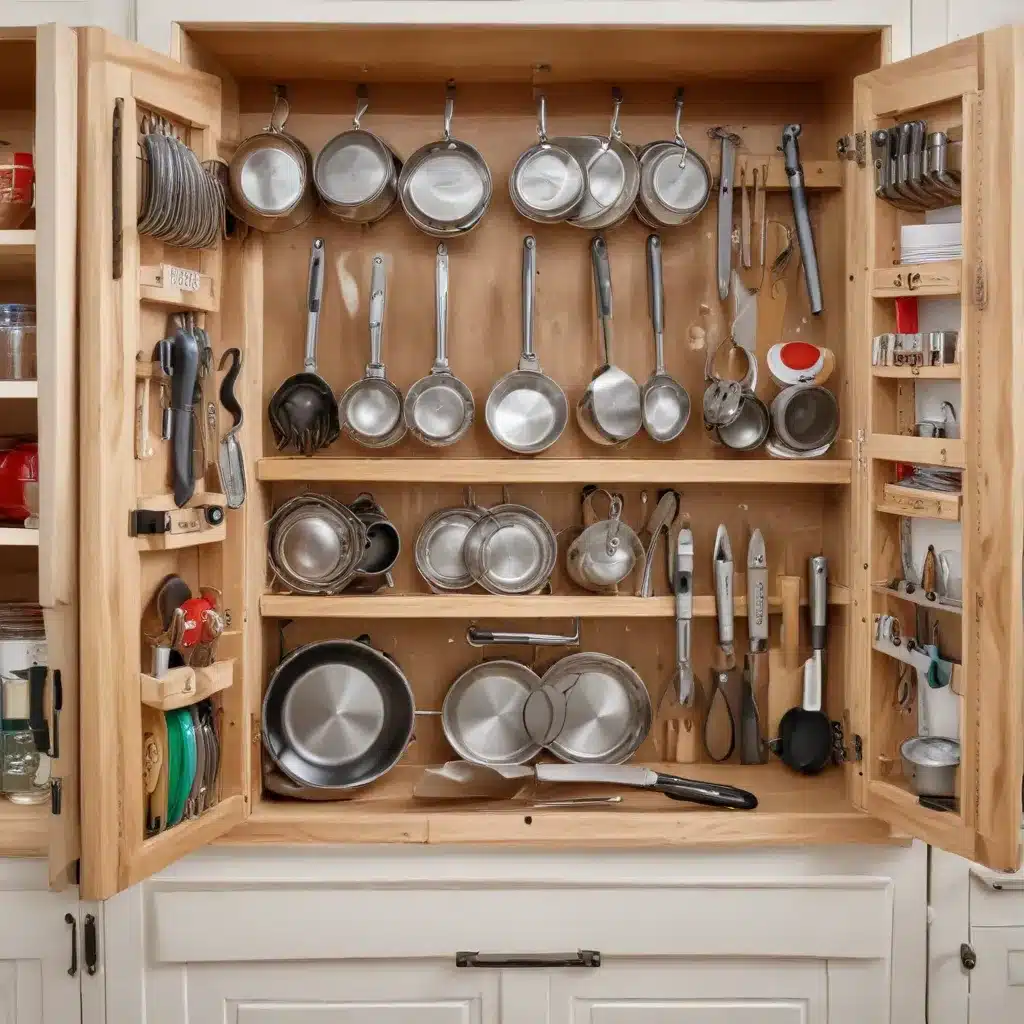
The Importance of an Organized Kitchen
As a seasoned culinary professional, I’ve learned that an efficient and well-organized kitchen is the foundation for culinary success. Whether you’re a home cook looking to streamline your meal prep or a commercial kitchen aiming to maximize productivity, taking the time to thoughtfully arrange your tools and workspace can make all the difference.
In today’s fast-paced culinary landscape, time is of the essence. By optimizing your kitchen layout and organizing your tools, you can minimize wasted movements, reduce prep time, and create a more enjoyable cooking experience. A properly organized kitchen not only saves you valuable time but also enhances safety, improves workflow, and supports your overall culinary creativity.
Establish Dedicated Cooking Zones
One of the key principles of an efficient kitchen design is to create distinct cooking zones that align with the natural flow of your culinary workflow. Dividing your kitchen into specific areas for prepping, cooking, cleaning, and storage can significantly streamline your operations.
Prep Zone: This is where the magic begins. Situate your cutting boards, knives, and frequently used ingredients within easy reach of your primary workspace. Ensure you have ample counter space for chopping, dicing, and mixing. Consider storing baking sheets and pans near this zone for seamless transition from prep to cooking.
Cooking Zone: Position your stove, oven, and other essential cooking equipment in close proximity to your prep area. This minimizes the distance ingredients need to travel from the prep zone to the heat source, maximizing efficiency. Maintain some open counter space adjacent to your cooking appliances to facilitate plating and serving.
Cleaning Zone: Placing your sink and dishwasher in close proximity to your cooking and prep zones allows you to easily clean as you go. This helps maintain a tidy workspace and reduces the time spent moving dirty dishes across the kitchen.
Storage Zone: Designate specific areas for storing your pantry items, spices, and lesser-used equipment. Keeping these items organized and easily accessible near their point of use can save you valuable time during the cooking process.
By defining these distinct zones and arranging your kitchen accordingly, you can create a harmonious flow that streamlines your culinary workflow and minimizes unnecessary steps.
Optimize Vertical Space
In a kitchen with limited square footage, learning to leverage vertical space is key to maximizing efficiency. Stacking shelves, installing pot racks, and utilizing the insides of cabinet doors can all help you make the most of your available space.
Consider adding risers or tiered shelving units to your cabinets, allowing you to double your storage capacity without sacrificing valuable counter space. Hang frequently used pots, pans, and utensils from a ceiling-mounted rack, keeping them within easy reach while freeing up cabinet space for less-accessed items.
Don’t neglect the potential of the insides of your cabinet doors either. Install hooks or slim racks to store lids, foil, and other flat, slender items, optimizing every inch of your kitchen.
Invest in Durable, Multifunctional Tools
When it comes to kitchen organization, the tools you choose can make all the difference. Prioritize durable, high-quality materials that can withstand the rigors of daily use and frequent cleaning. Stainless steel and ceramic tiles are excellent options for their longevity and easy-to-clean surfaces.
Furthermore, seek out multifunctional tools that can serve multiple purposes. For example, a good set of stackable food storage containers can double as mixing bowls or baking dishes, reducing the need for dedicated single-use items. Embracing versatile, high-quality tools not only maximizes your available space but also streamlines your cooking process.
Leverage Automation and Technology
In today’s modern kitchens, embracing automation and technology can be a game-changer for efficiency. Consider investing in appliances and tools that can automate repetitive tasks, such as programmable slow cookers, high-powered food processors, and smart dishwashers.
Kitchen management software and point-of-sale (POS) systems can also help streamline operations, automating inventory tracking, order management, and recipe organization. By integrating these technological solutions into your kitchen, you can free up valuable time and mental energy, allowing your culinary team to focus on their craft.
Create a Visually Appealing and Ergonomic Layout
The appearance and physical layout of your kitchen can have a significant impact on efficiency. Opt for a bright, cheerful color scheme that reflects light and creates a sense of cleanliness. Avoid dark or busy patterns that can make the space feel cramped and cluttered.
Additionally, consider ergonomic principles when arranging your workstations and equipment. Ensure that frequently used items are within easy reach, minimizing unnecessary bending, stretching, or reaching. Adjust counter heights and choose tools with user-friendly controls to support the comfort and productivity of your kitchen staff.
Embrace a Sustainable Mindset
As the culinary landscape evolves, implementing environmentally-conscious practices in your kitchen can enhance efficiency while also reducing your carbon footprint. Consider adopting sustainable strategies such as recycling, composting, and sourcing locally-grown ingredients.
Not only do these practices align with growing consumer demand for eco-friendly dining, but they can also lead to significant cost savings through reduced waste and efficient resource management. By embracing a sustainable mindset, you can elevate your kitchen’s efficiency and demonstrate your commitment to environmental stewardship.
Continuously Refine and Adapt
Optimizing your kitchen’s efficiency is an ongoing process. Regularly review and refine your layout, equipment placement, and workflow to ensure it continues to meet the evolving needs of your culinary operation.
Observe your kitchen staff in action, solicit feedback, and identify areas for improvement. Be open to making adjustments and implementing new organizational strategies as your menu, team, or customer demands change. By maintaining a culture of continuous improvement, you can ensure your kitchen remains a productive, efficient, and adaptable workspace.
Remember, a well-organized kitchen is not just about aesthetics – it’s a strategic foundation that empowers your culinary team to excel. By prioritizing efficient tool organization and optimizing your kitchen layout, you can unlock new levels of culinary creativity, productivity, and, ultimately, success. Visit KitchenWarrior.co.uk for more expert insights and practical tips to elevate your kitchen game.


